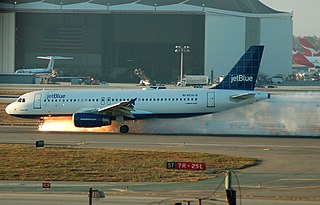Aviation is the design, development, production, operation, and use of aircraft, especially heavier-than-air aircraft. Articles related to aviation include:

Air Transat is a Canadian airline based in Montreal, Quebec. Founded in 1986, it operates scheduled and charter flights serving 60 destinations in 25 countries. Air Transat is owned and operated by Transat A.T. Inc., with 36 aircraft registered with Transport Canada as of September 2023.

Cruise is the phase of aircraft flight that starts when the aircraft levels off after a climb, until it begins to descend for landing. Cruising usually comprises the majority of a flight, and may include changes in heading, airspeed, and altitude.
This is a list of aviation-related events from 2000.

Air Transat Flight 236 was a transatlantic flight bound for Lisbon, Portugal, from Toronto, Canada, that lost all engine power while flying over the Atlantic Ocean on August 24, 2001. The Airbus A330 ran out of fuel because of a fuel leak caused by improper maintenance. Captain Robert Piché, 48, an experienced glider pilot, and First Officer Dirk DeJager, 28, glided the plane to a successful emergency landing in the Azores, saving all 306 people on board. Most of the passengers on the flight were Canadians visiting Europe or Portuguese expatriates returning to visit family in Portugal. This was also the longest passenger aircraft glide without engines, gliding for nearly 75 miles or 121 kilometres. Following this unusual aviation accident, this aircraft was nicknamed the "Azores Glider".

An emergency landing is a premature landing made by an aircraft in response to an emergency involving an imminent or ongoing threat to the safety and operation of the aircraft, or involving a sudden need for a passenger or crew on board to terminate the flight. It typically involves a forced diversion to the nearest or most suitable airport or airbase, or an off airport landing or ditching if the flight cannot reach an airfield. Flights under air traffic control will be given priority over all other aircraft operations upon the declaration of the emergency.

British Airways Flight 009, sometimes referred to by its callsign Speedbird 9 or as the Jakarta incident, was a scheduled British Airways flight from London Heathrow to Auckland, with stops in Bombay, Kuala Lumpur, Perth, and Melbourne.

Gimli Industrial Park Airport is a civilian airport and former military field located 2 nautical miles west of Gimli, Manitoba, Canada.

TACA Flight 110 was a scheduled international airline flight operated by TACA International Airlines, traveling from San Salvador to New Orleans, with a stopover in Belize City. On May 24, 1988, the flight encountered severe thunderstorm activity on its final approach to New Orleans International Airport. As a result, the brand new Boeing 737-300 suffered flameout in both engines while descending through a severe thunderstorm, but the pilots made a successful emergency landing on a grass levee adjacent to NASA's Michoud Assembly Facility, with no one aboard sustaining more than a few minor injuries, and with only minor hail damage to the intact aircraft. Following an on-site engine replacement, the jetliner took off from Saturn Boulevard, a road which had previously been an aircraft runway at Michoud. The aircraft was subsequently repaired and returned to service until it finally retired in 2016.

Falling from the Sky: Flight 174 is a 1995 Canadian thriller film directed by Jorge Montesi. Based on the events of Air Canada Flight 143, the film stars William Devane, Scott Hylands, Shelley Hack and Mariette Hartley. Set in 1983, the film follows the crew, their families and the passengers of the flight, from the preparations for departure to the emergency landing on an abandoned airfield in Manitoba, and everything in between.

In an internal combustion engine, fuel starvation is the failure of the fuel system to supply sufficient fuel to allow the engine to run properly, for example due to blockage, vapor lock, contamination by water, malfunction of the fuel pump or incorrect operation, leading to loss of power or engine stoppage. There is still fuel in the tank(s), but it is unable to get to the engine(s) in sufficient quantity. By contrast, fuel exhaustion is an occurrence in which the vehicle in question becomes completely devoid of usable fuel, with results similar to those of fuel starvation.
Robert Piché is a Canadian pilot. On August 24, 2001, he was captain of the Airbus A330 flying Air Transat Flight 236 and managed to land the aircraft safely in the Azores after it lost all power due to fuel exhaustion. As of February 2024, this remains a record glide length for a commercial aircraft in non powered flight. Piché and his co-pilot were later assigned partial responsibility for the incident.

China Airlines Flight 605 (CI605/CAL605) was a daily non-stop flight departing from Taipei at 6:30 a.m. and arriving at Kai Tak Airport in Hong Kong at 7:00 a.m. local time. On November 4, 1993, the plane went off the runway and overran while landing during a storm. It was the first hull loss of a Boeing 747-400.
Several aviation incidents and accidents have occurred in which the control surfaces of an aircraft became disabled, often due to failure of hydraulic systems or the flight control system. Other incidents have occurred where controls were not functioning correctly prior to take-off, either due to maintenance or pilot error, and controls can become inoperative from extreme weather conditions. Aircraft are not designed to be flown in such circumstances; however, a small number of pilots have had some success in flying and landing aircraft with disabled controls.
In aeronautics, loss of control (LOC) is the unintended departure of an aircraft from controlled flight and is a significant factor in several aviation accidents worldwide. In 2015 it was the leading cause of general aviation accidents. Loss of control may be the result of mechanical failure, external disturbances, aircraft upset conditions, or inappropriate crew actions or responses.









